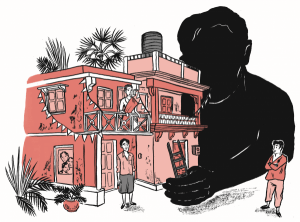William Nakabayashi at The Believer:
 Filmistan Studios occupies five acres in Goregaon, India, which is technically an outer suburb of Mumbai, but denser than most New York City neighborhoods. If you take the train from the city proper and fight the foot traffic that crowds the bazaar area around the station, you’ll reach a pair of steel gates. Just on the other side are Filmistan’s soundstages, which have been in continuous operation since 1943. In the Golden Age of Hindi Film, up to the 1960s, the industry worked along lines similar to those of the old Hollywood studio system, with each production house fielding its own stable of talent. Unlike most of its former rivals, Filmistan has remained open for business as a production facility, and the grounds now accommodate eight stages and several outdoor shooting areas, including a Hindu temple, a jailhouse exterior, and a village. But Filmistan is more than a collection of sets. Behind the scenes, there are real people living there. I came to Filmistan as an anthropologist in training, with a research project that looked solid enough, on paper, to win a Fulbright grant. One thing about ethnography they don’t teach you in school, though, is how awkward it can be getting started. Reaching out to people to do research with—soliciting “informants”—can feel like approaching strangers for a date. Left to myself in Mumbai, with my sun-glasses and clumsy Hindi, I was a field-work wallflower
Filmistan Studios occupies five acres in Goregaon, India, which is technically an outer suburb of Mumbai, but denser than most New York City neighborhoods. If you take the train from the city proper and fight the foot traffic that crowds the bazaar area around the station, you’ll reach a pair of steel gates. Just on the other side are Filmistan’s soundstages, which have been in continuous operation since 1943. In the Golden Age of Hindi Film, up to the 1960s, the industry worked along lines similar to those of the old Hollywood studio system, with each production house fielding its own stable of talent. Unlike most of its former rivals, Filmistan has remained open for business as a production facility, and the grounds now accommodate eight stages and several outdoor shooting areas, including a Hindu temple, a jailhouse exterior, and a village. But Filmistan is more than a collection of sets. Behind the scenes, there are real people living there. I came to Filmistan as an anthropologist in training, with a research project that looked solid enough, on paper, to win a Fulbright grant. One thing about ethnography they don’t teach you in school, though, is how awkward it can be getting started. Reaching out to people to do research with—soliciting “informants”—can feel like approaching strangers for a date. Left to myself in Mumbai, with my sun-glasses and clumsy Hindi, I was a field-work wallflower
more here.
